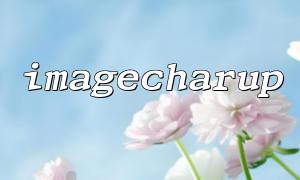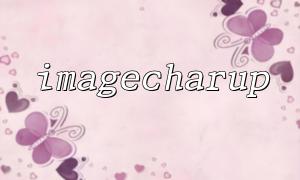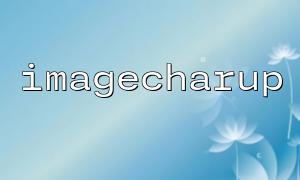When using PHP's GD library for image processing, imagecharup() is a function designed to draw a single character vertically within an image. Although it does not support the rich styles of TrueType fonts like imagettftext(), it can still handle basic character rendering tasks in certain simple scenarios. However, imagecharup() does not natively support italic or bold styles, so we need to employ programming tricks to "simulate" these effects.
The basic usage of the imagecharup() function is as follows:
imagecharup(resource $image, int $font, int $x, int $y, string $char, int $color): bool$image: The image resource
$font: The built-in font (0 to 5)
$x, $y: The starting coordinates of the character
$char: The character to be drawn
$color: The color identifier
This function will draw the character from bottom to top, arranging the characters vertically in the image.
The principle behind bold text is simple: by slightly offsetting the character's position and drawing it again, you can create a "bold" visual effect. This can be achieved by calling imagecharup() multiple times with slight positional offsets.
<?php
$image = imagecreatetruecolor(100, 100);
$white = imagecolorallocate($image, 255, 255, 255);
$black = imagecolorallocate($image, 0, 0, 0);
imagefill($image, 0, 0, $white);
<p>// Simulate bold<br>
$font = 4;<br>
$x = 50;<br>
$y = 80;<br>
$char = 'A';</p>
<p>for ($i = 0; $i < 2; $i++) {<br>
imagecharup($image, $font, $x + $i, $y, $char, $black);<br>
}</p>
<p>imagepng($image, 'bold.png');<br>
imagedestroy($image);<br>
?>By altering the $x or $y values, you can draw the same character multiple times, simulating the "thicker" edges. You can experiment with larger offsets to strengthen the effect.
Italic effects typically involve slanting the characters. While imagecharup() does not support rotating or skewing text, we can simulate this effect by shifting each character position slightly for each line.
One way to achieve this is by drawing each character individually, gradually increasing or decreasing the X-coordinate offset on the Y-axis to create a slanted arrangement.
<?php
$image = imagecreatetruecolor(100, 100);
$white = imagecolorallocate($image, 255, 255, 255);
$black = imagecolorallocate($image, 0, 0, 0);
imagefill($image, 0, 0, $white);
<p>$font = 3;<br>
$x = 40;<br>
$y = 80;<br>
$text = "PHP";</p>
<p>$offset = 0;<br>
for ($i = 0; $i < strlen($text); $i++) {<br>
$char = $text[$i];<br>
imagecharup($image, $font, $x + $offset, $y - $i * 15, $char, $black);<br>
$offset += 1; // Control the slant angle<br>
}</p>
<p>imagepng($image, 'italic.png');<br>
imagedestroy($image);<br>
?>The above code will draw the string PHP vertically while gradually increasing the X-coordinate to create a slanting effect. Although this method is not as flexible as TrueType fonts, it serves as a practical workaround when imagettftext() is unavailable.
Although the visual results of simulating italic and bold text with built-in fonts are limited, this approach remains useful for scenarios like icons, CAPTCHA, and embedded devices, where lightweight text rendering is needed. It can also meet specific needs in simple dynamic image applications.
You can output the generated image through PHP or save it to your server as follows:
header('Content-Type: image/png');
imagepng($image);
Or upload it to your own domain server, like:
// Output URL: https://gitbox.net/images/bold.png
These are the practical techniques for simulating italic and bold effects with imagecharup(). We hope this helps you apply this function flexibly in lightweight image processing tasks.





